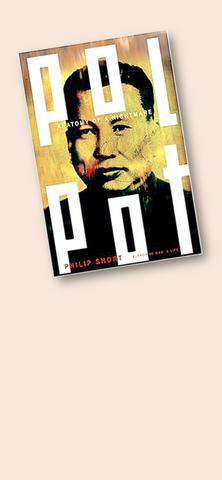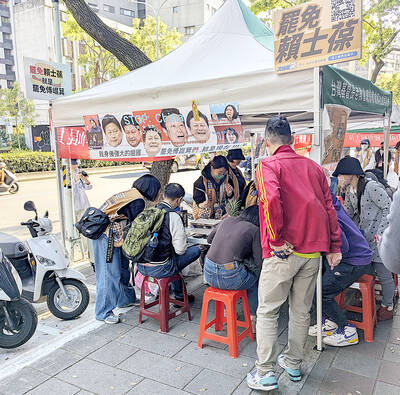Philip Short took four years to write this biography, after completing his much-praised life of Mao Zedong (毛澤東) in 1999. He has trawled deep and wide, reading what are probably just about all the written sources, but also interviewing the surprisingly large number of surviving and accessible former Khmer Rouge leaders.
Comparisons with Mao are inevitable. Despite the fact that, as Short claims, more of China's citizens died as a direct result of Mao's rule than have died under the rule of any leader in history, Mao's life has a heroic dimension that Pol Pot's cannot claim. Mao, for all his egregious faults, invites comparison with other revolution-consolidating figures such as Washington and Napoleon. Pol Pot's rule had no such dimensions. Instead, his small country has become a by-word for senseless extermination and his reign put the final nail worldwide into the coffin of communism as a credible ideal.

Short insists that it was French Marxism that underpinned Khmer Rouge ideology. Pol was a student in Paris, arriving on Oct. 1, 1949, the very day Mao stood at the Gate of Heavenly Peace in Beijing and announced the foundation of the People's Republic of China. At that time he had no political interests and was obsessed only with his new girlfriend. But a discussion group was formed, for Cambodian students focusing on liberation from colonial rule and its roots lay in Marxist theory. (In the early 1950s some 25 percent of the French electorate voted communist, more than for any other political grouping). Thus, when Phnom Penh was devastatingly emptied of its inhabitants in April 1975, it was the Paris Commune of 1871 that Pol cited, saying it had been overthrown because the proletariat had failed to exercise dictatorship over the bourgeoisie, and he wasn't going to repeat the mistake.
Unlike William Shawcross in Sideshow: Kissinger, Nixon and the Destruction of Cambodia,(1991), Short doesn't believe massive US bombing was a direct cause of the brutality of the Khmer Rouge regime, though he agrees three times the tonnage of bombs was dropped on Cambodia than was dropped on Japan in World War II, atom bombs included. Instead, it had other causes -- a traditional Khmer belief in fate and the doomed nature of the weak, the Khmer Rouge soldiers' extreme youth and lack of education (some believed Phnom Penh's Western-style toilets were wells for drinking water), their knowledge that to hold back might bring rebuke whereas going too far would never be censured, and so on.
Nevertheless, horror certainly prevailed. When the film The Killing Fields was being made, Cambodians shown preliminary footage insisted that things had in reality been much worse. The filmmakers didn't make any changes, however, saying that if they did, audiences simply wouldn't believe it.
As for his interview material, some analysts have insisted on disbelieving anyone implicated in the nightmare. Short, though, argues that most are likely to be telling the truth when there are no indications to the contrary. He became adept in seeing when his questions were considered too probing and evasions ensued, and generally accepts what he was told up to that point.
A concept that recurs throughout the book is the divide in Asia between the Chinese-influenced, essentially Confucian territories and the Indian-influenced, Theravada Buddhist, ones. In the region, Vietnam belongs to the first group, Cambodia, together with Thailand and Laos, to the second. Asian Marxism, as formulated by Mao, was in essence a Chinese construct, Short says, and things were inevitably different in Cambodia -- a medieval society whose peasants couldn't conceive of another successful rice harvest after the deposition of the god-king Sihanouk.
The 20th century produced many political monsters, and the public has largely been happy to account for them simply in terms of "evil," Hitler, Stalin and Pol Pot are frequently written off as deranged individuals out of a horror movie who somehow managed to obtain real power. But they too had their ideals. Hitler dreamed of a Germany populated by flaxen-haired vegetarians in rose-covered cottages who painted landscapes and listened to Wagner. And Pol Pot was a mild-mannered man with a winning smile who first wanted independence from France, then came to believe in a fundamentalist Marxism rooted in the soil as the only way to recover the greatness that had produced Angkor Wat.
Philip Short's qualities are a lack of dogmatism and a sage international perspective. He points out, for instance, that after the fall of the pro-German Vichy government in France in 1945, the number of revenge killings of collaborators was proportionally similar to those in Cambodia after the fall of Lon Nol. All totalitarian regimes torture and kill their opponents, he writes elsewhere, and all soldiers are trained to ignore pity. If he has a general theory, it is that Cambodia was not an aberration, but rather a society where malign forces present in other places collided with particular intensity.
Pol Pot is both comprehensive and highly readable. Experts in the field point to earlier works on Pol such as Nyan Chander's Brother Enemy (1986), but Short's humane account looks set to stand close to the cutting-edge in this daunting, but inevitably thought-provoking, historical territory.

That US assistance was a model for Taiwan’s spectacular development success was early recognized by policymakers and analysts. In a report to the US Congress for the fiscal year 1962, former President John F. Kennedy noted Taiwan’s “rapid economic growth,” was “producing a substantial net gain in living.” Kennedy had a stake in Taiwan’s achievements and the US’ official development assistance (ODA) in general: In September 1961, his entreaty to make the 1960s a “decade of development,” and an accompanying proposal for dedicated legislation to this end, had been formalized by congressional passage of the Foreign Assistance Act. Two

Despite the intense sunshine, we were hardly breaking a sweat as we cruised along the flat, dedicated bike lane, well protected from the heat by a canopy of trees. The electric assist on the bikes likely made a difference, too. Far removed from the bustle and noise of the Taichung traffic, we admired the serene rural scenery, making our way over rivers, alongside rice paddies and through pear orchards. Our route for the day covered two bike paths that connect in Fengyuan District (豐原) and are best done together. The Hou-Feng Bike Path (后豐鐵馬道) runs southward from Houli District (后里) while the

On March 13 President William Lai (賴清德) gave a national security speech noting the 20th year since the passing of China’s Anti-Secession Law (反分裂國家法) in March 2005 that laid the legal groundwork for an invasion of Taiwan. That law, and other subsequent ones, are merely political theater created by the Chinese Communist Party (CCP) to have something to point to so they can claim “we have to do it, it is the law.” The president’s speech was somber and said: “By its actions, China already satisfies the definition of a ‘foreign hostile force’ as provided in the Anti-Infiltration Act, which unlike

Mirror mirror on the wall, what’s the fairest Disney live-action remake of them all? Wait, mirror. Hold on a second. Maybe choosing from the likes of Alice in Wonderland (2010), Mulan (2020) and The Lion King (2019) isn’t such a good idea. Mirror, on second thought, what’s on Netflix? Even the most devoted fans would have to acknowledge that these have not been the most illustrious illustrations of Disney magic. At their best (Pete’s Dragon? Cinderella?) they breathe life into old classics that could use a little updating. At their worst, well, blue Will Smith. Given the rapacious rate of remakes in modern